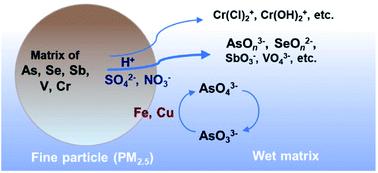当前位置:
X-MOL 学术
›
Environ. Sci.: Processes Impacts
›
论文详情
Our official English website, www.x-mol.net, welcomes your
feedback! (Note: you will need to create a separate account there.)
Determination of oxoanions and water-soluble species of arsenic, selenium, antimony, vanadium, and chromium eluted in water from airborne fine particles (PM2.5): effect of acid and transition metal content of particles on heavy metal elution.
Environmental Science: Processes & Impacts ( IF 4.3 ) Pub Date : 2020-05-29 , DOI: 10.1039/d0em00135j Misaki Taira 1 , Kunio Sakakibara , Kentaro Saeki , Shin-Ichi Ohira , Kei Toda
Environmental Science: Processes & Impacts ( IF 4.3 ) Pub Date : 2020-05-29 , DOI: 10.1039/d0em00135j Misaki Taira 1 , Kunio Sakakibara , Kentaro Saeki , Shin-Ichi Ohira , Kei Toda
Affiliation

|
Heavy metals in particulate matter (PM) are of great concern, and their effects on the environment and human health depend on their solubilities and species present. In this study, the solubility of As, Se, Sb, V and Cr and their species eluted in water was investigated. As, Se, Sb, and V were present mostly in fine particles, and they were predominantly water-soluble in fine particles (<2.5 μm, PM2.5) but insoluble in coarse particles (>2.5 μm). Solubility of Cr was poor even in fine particles. It was found that for fine particles, solubilities of the heavy metals were related to the nitrate and sulfate contents. This suggests that the higher the acidity of the particles, the higher the solubility of the heavy metals. Oxoanions of the five kinds of heavy metals in water extracts of fine particles were determined by inductively coupled plasma mass spectrometry preceded by ion chromatography. The results suggested the presence of atmospheric oxidation during the aerosol transportation. Also, the As(III)/As(V) (arsenite/arsenate) ratios for the fine particle extracts were related to the transition metal concentrations, which indicated that Fe, Cu, etc. in fine particles affected the As redox equilibrium. It was suggested that the heavy metals exist as complexes with iron hydroxide and dissolved organic matter in addition to the free oxoanions. These investigations were performed for PM samples collected in winter and summer in Kumamoto, west Japan, where the site is strongly exposed to westerly winds from continental East Asia. The obtained results improve our understanding of the behavior of the heavy metals in airborne PM after depositing on a wet environment and biota.
中文翻译:

测定空气中细颗粒物(PM2.5)洗脱出的水中的氧阴离子和砷,硒,锑,钒和铬的水溶性物质:酸和过渡金属含量对重金属洗脱的影响。
颗粒物(PM)中的重金属受到极大关注,它们对环境和人类健康的影响取决于其溶解度和所存在的物种。在这项研究中,研究了As,Se,Sb,V和Cr及其物种在水中的溶解度。As,Se,Sb和V主要存在于微粒中,并且主要溶于水溶性微粒(<2.5μm,PM 2.5),但不溶于粗颗粒(> 2.5μm)。即使在细颗粒中,Cr的溶解性也很差。发现对于细颗粒,重金属的溶解度与硝酸盐和硫酸盐含量有关。这表明颗粒的酸度越高,重金属的溶解度越高。细颗粒水提取物中的五种重金属的氧阴离子通过电感耦合等离子体质谱法测定,然后进行离子色谱法测定。结果表明在气溶胶运输过程中存在大气氧化。同样,细颗粒提取物的As(III)/ As(V)(亚砷酸盐/砷酸盐)之比与过渡金属浓度有关,表明Fe,Cu等。在细颗粒中影响了As的氧化还原平衡。有人提出,除了游离的氧阴离子外,重金属还与氢氧化铁和溶解的有机物形成络合物。这些调查是针对冬季和夏季在日本西部的熊本市收集的PM样品进行的,该地点极度暴露于东亚大陆的西风。获得的结果提高了我们对沉积在潮湿环境和生物区系中的机载PM中重金属行为的了解。
更新日期:2020-07-22
中文翻译:

测定空气中细颗粒物(PM2.5)洗脱出的水中的氧阴离子和砷,硒,锑,钒和铬的水溶性物质:酸和过渡金属含量对重金属洗脱的影响。
颗粒物(PM)中的重金属受到极大关注,它们对环境和人类健康的影响取决于其溶解度和所存在的物种。在这项研究中,研究了As,Se,Sb,V和Cr及其物种在水中的溶解度。As,Se,Sb和V主要存在于微粒中,并且主要溶于水溶性微粒(<2.5μm,PM 2.5),但不溶于粗颗粒(> 2.5μm)。即使在细颗粒中,Cr的溶解性也很差。发现对于细颗粒,重金属的溶解度与硝酸盐和硫酸盐含量有关。这表明颗粒的酸度越高,重金属的溶解度越高。细颗粒水提取物中的五种重金属的氧阴离子通过电感耦合等离子体质谱法测定,然后进行离子色谱法测定。结果表明在气溶胶运输过程中存在大气氧化。同样,细颗粒提取物的As(III)/ As(V)(亚砷酸盐/砷酸盐)之比与过渡金属浓度有关,表明Fe,Cu等。在细颗粒中影响了As的氧化还原平衡。有人提出,除了游离的氧阴离子外,重金属还与氢氧化铁和溶解的有机物形成络合物。这些调查是针对冬季和夏季在日本西部的熊本市收集的PM样品进行的,该地点极度暴露于东亚大陆的西风。获得的结果提高了我们对沉积在潮湿环境和生物区系中的机载PM中重金属行为的了解。











































 京公网安备 11010802027423号
京公网安备 11010802027423号